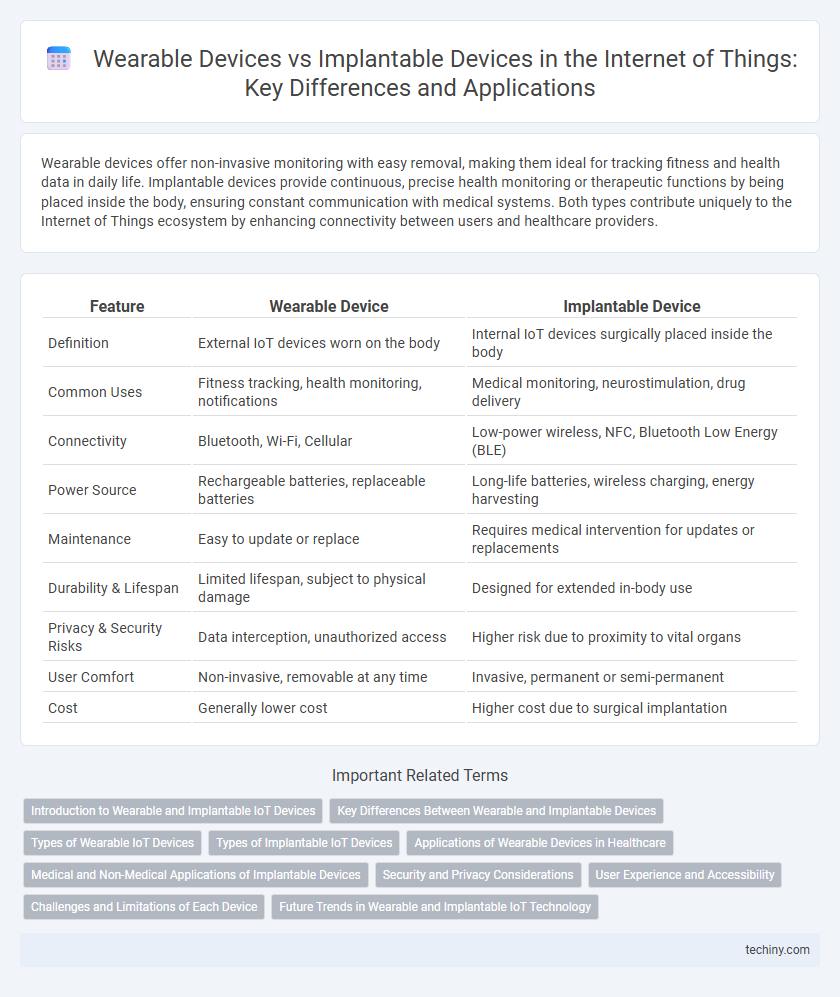Wearable devices offer non-invasive monitoring with easy removal, making them ideal for tracking fitness and health data in daily life. Implantable devices provide continuous, precise health monitoring or therapeutic functions by being placed inside the body, ensuring constant communication with medical systems. Both types contribute uniquely to the Internet of Things ecosystem by enhancing connectivity between users and healthcare providers.
Table of Comparison
| Feature | Wearable Device | Implantable Device |
|---|---|---|
| Definition | External IoT devices worn on the body | Internal IoT devices surgically placed inside the body |
| Common Uses | Fitness tracking, health monitoring, notifications | Medical monitoring, neurostimulation, drug delivery |
| Connectivity | Bluetooth, Wi-Fi, Cellular | Low-power wireless, NFC, Bluetooth Low Energy (BLE) |
| Power Source | Rechargeable batteries, replaceable batteries | Long-life batteries, wireless charging, energy harvesting |
| Maintenance | Easy to update or replace | Requires medical intervention for updates or replacements |
| Durability & Lifespan | Limited lifespan, subject to physical damage | Designed for extended in-body use |
| Privacy & Security Risks | Data interception, unauthorized access | Higher risk due to proximity to vital organs |
| User Comfort | Non-invasive, removable at any time | Invasive, permanent or semi-permanent |
| Cost | Generally lower cost | Higher cost due to surgical implantation |
Introduction to Wearable and Implantable IoT Devices
Wearable IoT devices, such as smartwatches and fitness trackers, continuously monitor health metrics and activity data through sensors embedded in everyday accessories. Implantable IoT devices, including pacemakers and glucose monitors, provide real-time internal body data by being surgically inserted for chronic condition management and advanced medical diagnostics. Both device types leverage wireless connectivity and data analytics to enhance personalized healthcare and improve patient outcomes.
Key Differences Between Wearable and Implantable Devices
Wearable devices are external gadgets designed to monitor health metrics like heart rate and activity levels, whereas implantable devices are surgically embedded within the body to provide continuous, real-time physiological monitoring or therapeutic interventions. Wearables offer non-invasive convenience and easy accessibility but may suffer from limited accuracy and battery life compared to implantables, which ensure precise data collection and uninterrupted function with bio-compatible materials. The choice between wearable and implantable IoT devices hinges on application requirements, with implantables suited for critical medical conditions demanding constant monitoring and wearables better for general wellness tracking and lifestyle management.
Types of Wearable IoT Devices
Wearable IoT devices include fitness trackers, smartwatches, and health monitors designed for continuous data collection and real-time health monitoring. These devices leverage sensors to track metrics such as heart rate, sleep patterns, and physical activity, providing actionable insights through connected apps. Unlike implantable devices, wearables offer non-invasive, easily accessible technology for lifestyle management and preventive healthcare.
Types of Implantable IoT Devices
Implantable IoT devices encompass a range of medical technologies such as pacemakers, cochlear implants, and glucose monitoring sensors designed for continuous health tracking and therapeutic intervention. These devices leverage wireless communication to transmit real-time data to healthcare providers, enabling personalized treatment and early intervention. The miniaturization of sensors and enhanced biocompatibility materials play a crucial role in the development and functionality of these implantable technologies within the Internet of Things ecosystem.
Applications of Wearable Devices in Healthcare
Wearable devices in healthcare are extensively utilized for continuous monitoring of vital signs such as heart rate, blood pressure, and oxygen saturation, enabling real-time health tracking and early detection of medical conditions. These devices support chronic disease management by collecting data to optimize treatment plans for conditions like diabetes and cardiovascular diseases. Fitness tracking, sleep analysis, and fall detection are additional healthcare applications that improve patient outcomes and promote proactive health management.
Medical and Non-Medical Applications of Implantable Devices
Implantable devices in the Internet of Things ecosystem provide continuous health monitoring and therapeutic functions, crucial for medical applications such as cardiac pacemakers, glucose sensors, and neurostimulators. Non-medical applications of implantables include biometric authentication, performance enhancement in athletes, and interactive augmented reality experiences. These devices offer seamless integration with IoT networks, enabling real-time data transmission and personalized user insights for improved health and lifestyle management.
Security and Privacy Considerations
Wearable devices in the Internet of Things (IoT) offer convenient health monitoring but often face vulnerabilities due to wireless data transmission, raising concerns about unauthorized access and data interception. Implantable devices, embedded within the body, require stringent encryption and robust authentication protocols to safeguard sensitive medical information and prevent malicious attacks. Ensuring end-to-end security and maintaining user privacy are critical challenges for both device types, necessitating continuous updates and compliance with healthcare cybersecurity standards.
User Experience and Accessibility
Wearable devices offer high user accessibility through easy removal and non-invasive interaction, enhancing comfort and convenience for continuous monitoring. Implantable devices provide more precise data and seamless integration with the body but require surgical procedures, which can limit accessibility and user acceptance. User experience balances comfort and data accuracy, with wearables prioritizing ease of use while implantables emphasize long-term health insights.
Challenges and Limitations of Each Device
Wearable devices face challenges such as limited battery life, bulkiness, and susceptibility to environmental factors like moisture and impact, which can affect their durability and continuous usage. Implantable devices encounter significant limitations including biocompatibility concerns, risk of infection, complex surgical procedures for insertion and removal, and restricted battery replacement options that demand efficient energy management. Both device types also struggle with secure data transmission and privacy protection within IoT ecosystems, necessitating robust encryption and authentication protocols.
Future Trends in Wearable and Implantable IoT Technology
Future trends in wearable and implantable IoT technology emphasize enhanced biocompatibility, miniaturization, and seamless integration with AI-driven health monitoring systems. Wearable devices are evolving to include advanced sensors for continuous real-time data collection, while implantable devices focus on secure wireless communication and energy harvesting to extend device lifespan. The convergence of edge computing and 5G connectivity enables faster data processing and improved responsiveness, transforming personalized healthcare and chronic disease management.
Wearable device vs Implantable device Infographic

 techiny.com
techiny.com